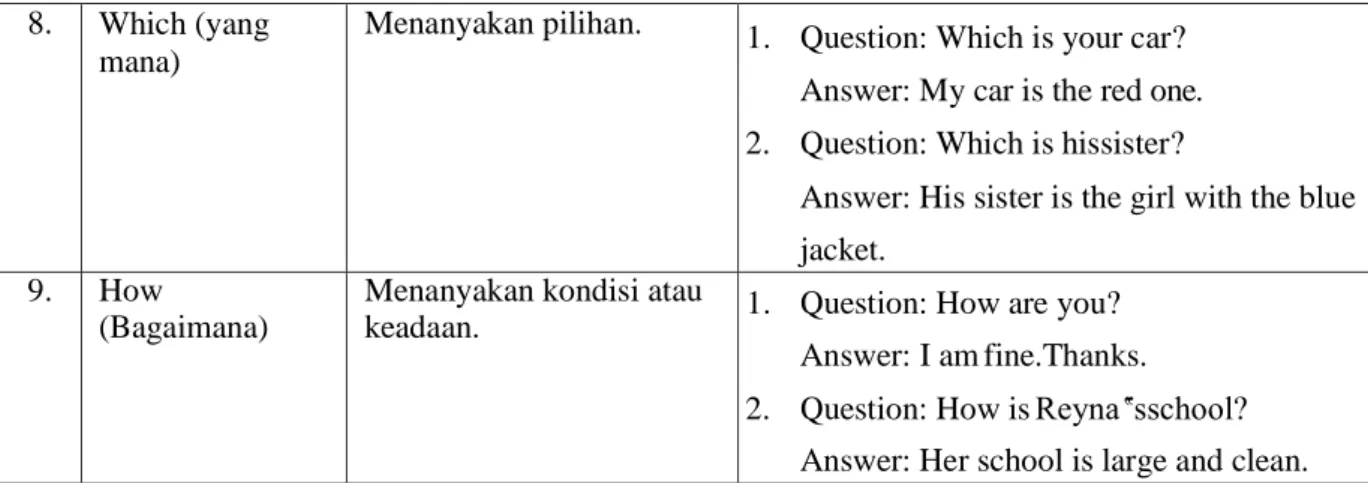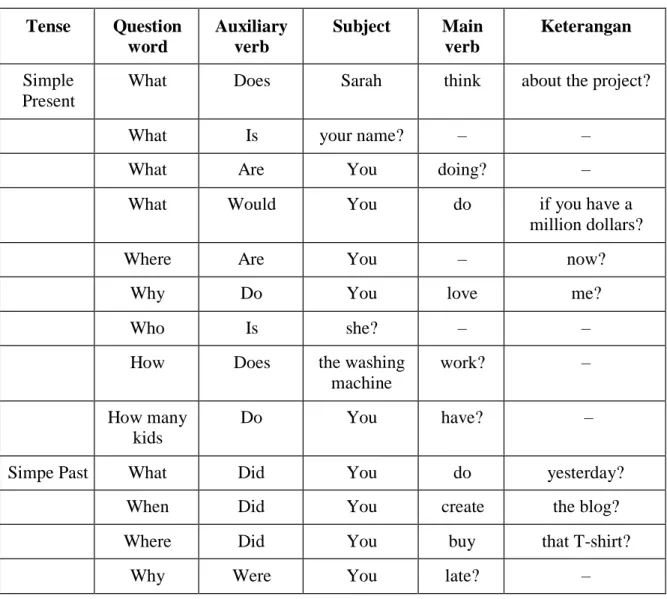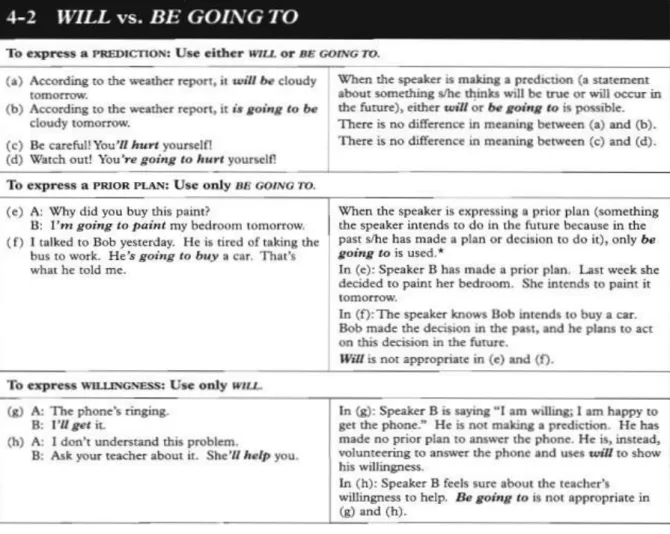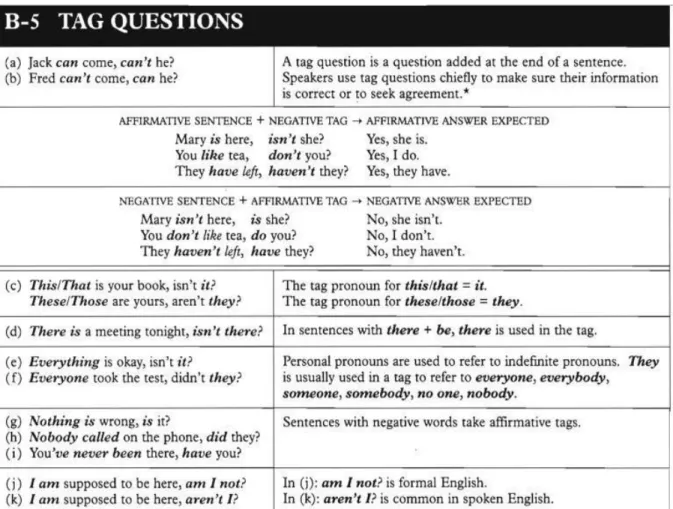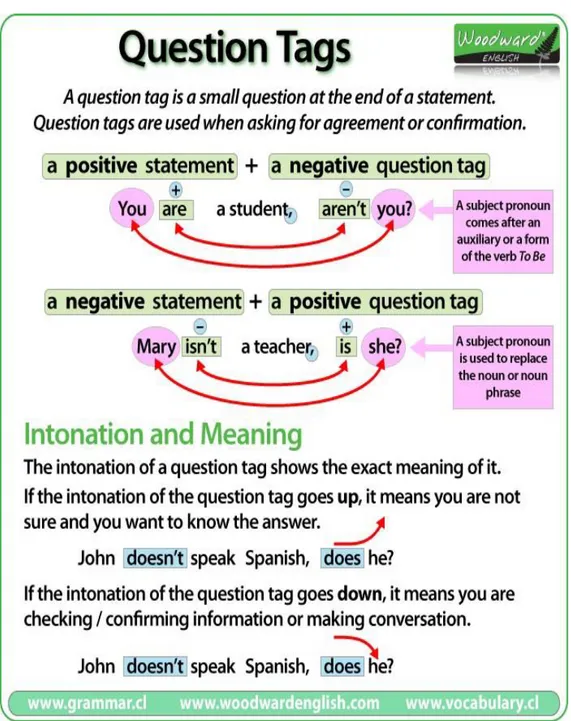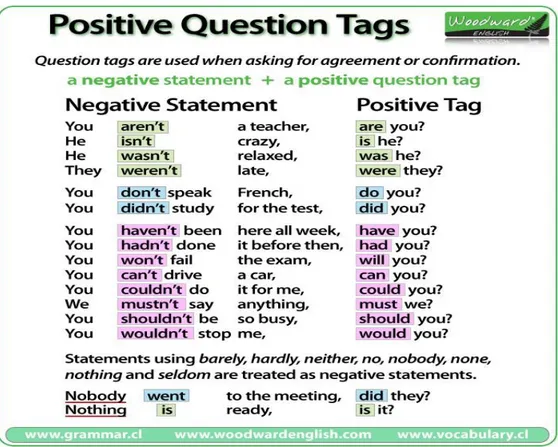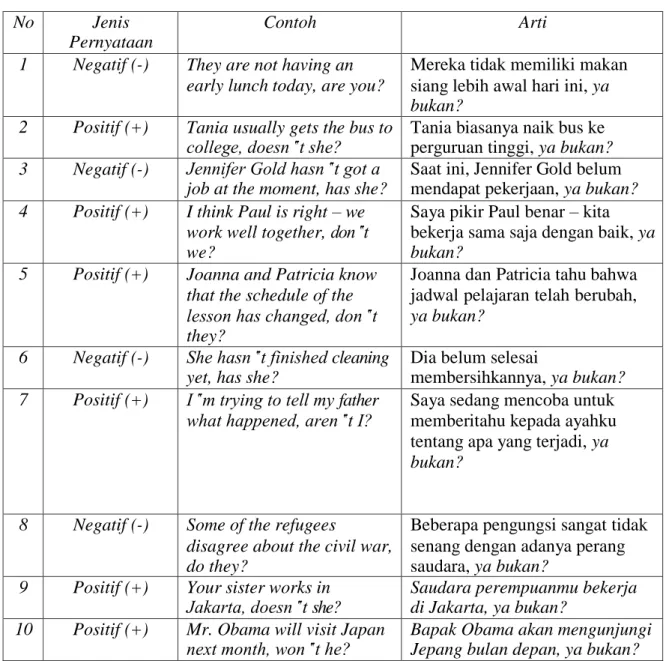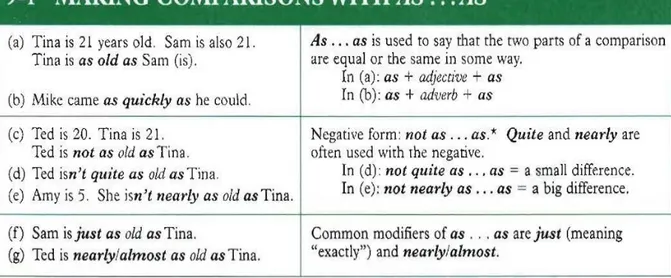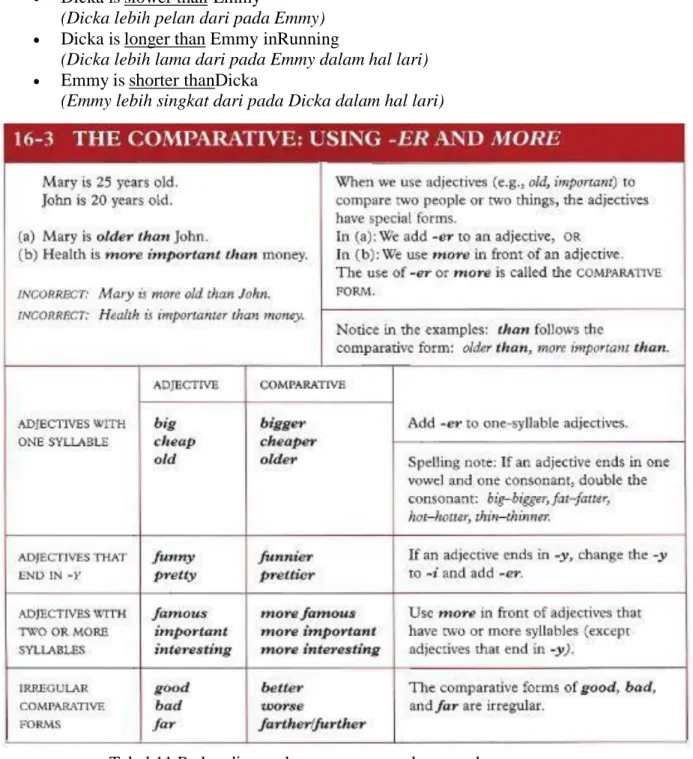Fakultas Program Studi SKS Kode MK Di susun Oleh FFIKes DIII - Keperawatan
1
WATU . 005 Mey Lina GirsangMODUL PRAKTIK BAHASA INGGRIS
FAKULTAS FARMASI DAN ILMU KESEHATAN UNIVERSITAS SARI MUTIARA INDONESIA
Visi Prodi :
Menjadi Program Studi Yang Unggul, Berkarakter dan Berdaya Saing Global Khususnya Keperawatan Medikal Bedah Tahun 2038”
Visi Prodi :
Menjadi Program Studi Yang Unggul, Berkarakter dan Berdaya Saing Global Khususnya Keperawatan Medikal Bedah Tahun 2038”
LEMBAR PENGESAHAN MODUL
1. IDENTITAS MODUL
MATA KULIAH : BAHASA INGGRIS
SEMESTER : DUA (II)
TAHUN AKADEMIK : 2019/2020 2. IDENTITAS DOSEN
NAMA : Mey Lina Girsang M.pd
NIDN : 0115059101
DISETUJUI DAN DISAHKAN DI:MEDAN TANGGAL : MARET 2020
PROGRAM STUDI DIII KEPERAWATAN KETUA,
Ns.Flora Sijabat S.Kep, MNS
KATA PENGANTAR
Segala puji bagi Tuhan Yang Maha Esa yang senantiasa memberikan kemudahan dalam menyelesaikan segala urusan hingga penulis mampu menyelesaikan Modul Perkuliahan Mata Kuliah Bahasa Inggris Lanjutan. Tak lupa penulis juga mengucapkan ribuan terima kasih kepada berbagai pihak yang telah membantu dalam penyelesaian modul ini.
Pembelajaran Bahasa Inggris, khususnya di Universitas Sari Mutiara Indonesia (USM- Indonesia) memiliki peran yang sangat penting. Sebab setiap mata kuliah tidak lepas dengan buku, jurnal, referensi, dan istilah dalam bahasa Inggris. Untuk itu USM-Indonesia membuka Mata Kuliah Bahasa Inggris sebanyak dua kategori yaitu Bahasa Inggris dasar untuk semester 2 dan bahasa Inggris II atau tiga untuk semester 4 dan 6. Dengan adanya mata kuliah tersebut dipandang perlu adanya buku acuan seperti halnya Modul Pembelajaran Bahasa Inggris demi menunjang proses belajar mengajar mata kuliah Bahasa Inggris di USM-Indonesia
Modul Perkuliahan Mata Kuliah Bahasa Inggris Lanjutan ini merupakan lanjutan dari Bahasa Inggris Dasar. Didalam Bahasa Inggris Lanjutan ini lebih menitik beratkan pada pengetahuan Bahasa Inggris lanjutan mengenai konsep lanjutan tentang English Element atau elemen-elemen yang ada dalam bahasa inggris (Vocabulary, Grammar/structure, dan pronounciation). Dalam proses pembelajaran bahasa Inggris tentunya perlu kiranya untuk terus dilakukan penataan kembali pola pemahaman dan juga materi atau bahan ajar bahasa Inggris secara sistematis dalam bentuk skemata atau konsep-konsep yang lebih simple dan mudah untuk dipahami, karena mengingat karakteristik mahasiswa D3 USM-Indonesia yang bukan mahasiwa program bahasa sehingga diperlukan desain materi yang yang lebih sederhana. Modul ini memuat ringkasan materi bahasa Inggris dengan didikuti latihan-latihan soal yang disusun secara sederhana dan sistematis menurut kaidah-kaidah gramatika Bahasa Inggris tertentu, yang dianggap esensial sebagai dasar untuk mengembangkan keterampilan bahasa lisan maupun tulisan (spoken / written) seperti pola-pola dasar kalimat bahasa Inggris, seperti: wh-question, modals, introductory IT, another and the other, to be + going to and will, question-tag, degree of comparison, elliptical sentence, conditional sentence type 1, 2, and 3, dan preference. Selain itu, didalam Bahasa Inggris Lanjutan ini juga terdapat materi Reading Comprehension 1 dan 2. Hal tersebut dipandang perlu sebab mahasiswa tidak hanya diajarkan mengenai grammar tetapi juga dilatih untuk memahami bacaaan / wacana berbentuk bahasa Inggris. Dengan harapan bekal tersebut dapat berguna dikemudian hari.Amin.
Akhir kata penulis mengucapkan selamat membaca dan berpandang mesra dengan dunia bahasa Inggris yang penulis sajikan. Dan tentu tidak lupa penulis harapkan kritik dan saran yang membangun agar didalam membuat modul penulis senantiasa rajin berbenah.
DAFTAR ISI
Halaman Judul ... i
KataPengantar ... ii
DaftarIsi ... iii
Unit1 Wh-question ... 1
Unit 2 Modals (can, could, may,might, must) ... 8
Unit 3 Introductory“it” ... 13
Unit 4 Singular Forms of Other : Another vs.the Other ... 16
Unit 5 To be + going to and Will ... 20
Unit 6 Reading Comprehension1(Surprise!) ... 25
Unit7 Tag-Questions ... 34
Unit 8 Degree of Comparison ... 39
Unit 9 Reading Comprehension 2 (Ohthe Horror!) ... 48
Unit 10Elliptical Sentence ... 60
Unit 11 ConditionalType1 ... 64
Unit 12 Conditional Type 2and 3 ... 66
Unit13 Preference ... 69
DaftarPustaka ... 72
UNIT 1
WH-QUESTIONS
A. DefinisiWh-Questions
Information Questions (Wh-Questions dan how) adalah bentuk pertanyaan yang menanyakan informasi dengan menggunakan Question Words (kata tanya). Sering disebut dengan Wh-question karena semua kata tanya diawali dengan Wh-, kecuali How.
Yang termasuk Question Words (QW) adalah: What, Who, Whom, Whose, Why, Where, When, Which dan How. Karena Questions Words ini terdiri dari 9 buah kata tanya, oleh karena itu kata tanya ini lazim disebut 8W+1H.
B. Perbedaan Yes-No Questions dengan InformationQuestions
Gambar 1 Perbedaan Yes-No Questions dengan Information Questions
Dari gambar diatas terlihat jelas perbedaan antara Yes-No Questions dengan Information Questions, dimana yes/no questions merupakan bentuk pertanyaan yang dapat dijawab dengan jawaban Yes atau No, sementara information questions adalah bentuk pertanyaan yang bertujuan untuk menanyakan informasi dengan menggunakan kata tanya (question word), yaitu where, when, why, who, whom, what, which, whose, dan how (Azar,2003:123).
C. Macam-macam, fungsi, dan contohWh-Questions
No. Wh-Questions Fungsi Contoh
1. What (apa) Menanyakan nama benda, nama orang atau jenis profesi.
1. Question: What is that?
Answer: That is anapple.
2. Question: What are you?
Answer: I am asoldier.
3. Question: What is your name? Answer:
My name isIvanka.
2. Who (siapa) Menanyakan orang sebagai pelaku/subject.
1. Question: Who are you?
Answer: I am JokoPinurbo.
2. Question: Who writes the letter?
Answer: Martindoes.
3. Who is verybeautiful?
Answer: Agnes Monica is very beautiful.
3. Whom (siapa) Menanyakan orang sebagai object.
1. Question: Whom do you meet?
Answer: I meet InulDaratista.
2. Question: Whom is she looking for?
Answer: She is looking for BrianSafina.
4. Whose (milik siapa)
Menanyakan pemilik suatu benda.
1. Question: Whose bag is this?
Answer: This is mybag
2. Question: Whose sister is thegirl?
Answer: She is my sister 5. Why (mengapa) Menanyakan alasan atau
penyebab terjadinya sesuatu.
1. Question: Why do you come late?
Answer: Because I missed the bus this morning
2. Question: Why is Mrs. Julia very healthy?
3. Answer: Because she does sport every morning.
4. Question: Why do you loveme?
5. Answer: Because you are veryrich.
6. Where (dimana) Menanyakan tempat. 1. Question: Where does Alicia study?
Answer: She studies in SMPN 03 Wonogiri.
2. Question: Where do you go everyday?
Answer: I go to school everyday.
3. Question: Where is the library?
Answer: The library is beside thehall.
7. When (kapan) Menanyakan waktu. 1. Question: When does Alfian get up?
Answer: He gets up at five o‟clockevery morning.
2. Question: When did you go toEromoko?
Answer: I go to Eromoko lastweek.
3. Question: When do you go to school?
Answer: I go to school at06.30.
8. Which (yang mana)
Menanyakan pilihan. 1. Question: Which is your car?
Answer: My car is the red one.
2. Question: Which is hissister?
Answer: His sister is the girl with the blue jacket.
9. How
(Bagaimana)
Menanyakan kondisi atau
keadaan. 1. Question: How are you?
Answer: I am fine.Thanks.
2. Question: How is Reyna‟sschool?
Answer: Her school is large and clean.
Tabel 1 Macam-macam, fungsi, dan contoh Wh-Questions
D. Penjelasan tambahan mengenai who, whom, danhow.
1. Who (Siapa, sebagaisubjek)
a. Who digunakan untuk menanyakan orang (sebagai subjek). Contoh kalimatnya bisa Anda lihat di bawahini:
1. Who is that? [Siapaitu?]
2. Who is going to come with Messi? [Siapa yang akan datang dengan Messi?]
3. Who is she dating now? [Siapa yang sedang dia kencanisekarang?]
4. Who can help me bring this table? [Siapa yang bisa membantu saya membawa mejaini?]
5. Who were you calling? [Siapa yang sedang Andatelepon?
6. Who will you invite to the party? [Siapa yang akan Anda undang ke pesta?]
b. Selain itu, who juga bisa langsung diikuti oleh kata kerja. Perhatikan contoh- contohnya di bawah ini:
1. Who wants to eat? [Siapa yang maumakan?]
2. Who cares? [Siapa yangpeduli?]
3. Who won the match? [Siapa yang memenangkan pertandingan?]
4. Who wrote the Harry Potter? [Siapa yang menulis HarryPotter?]
2. Whom (Siapa, sebagaiobjek)
Berbeda dengan who, whom digunakan untuk menanyakan orang sebagai objek.
Contoh kalimatnya dijelaskan pada gambar 2 sebagai berikut:
Gambar 2. Perbedaan who dengan whom
3. How (Bagaimana, Berapa,Seberapa)
How biasanya digunakan untuk menanyakan cara, kondisi/kualitas, kabar/kesehatan seseorang, jumlah (yang dapat dan tidak dapat dihitung), usia, jarak, durasi, dan frekuensi. Contoh kalimatnya adalah sebagai berikut:
a. How does the washing machine work? [Bagaimana cara kerja mesincuci?]
b. How was your exam? [Bagaimana ujianAnda?]
c. How are you? [Bagaimana kabarAnda?]
d. How many children does Parto have? [Berapa banyak anak yang Parto miliki?]
e. How much money have you spent this month? [Berapa banyak uang yang telah Anda habiskan bulanini?]
f. How old are you? [Berapa usiaAnda?]
g. How far is Bali from Jakarta? [Seberapa jauh Bali dariJakarta?]
h. How long can you go? [Berapa lama Anda bisapergi?]
i. How often do you visit your grandmother? [Seberapa sering Anda mengunjungi nenekAnda?]
E. Tips membentuk/membuatWh-Questions
Yang perlu diingat dalam membentuk/membuat Wh-Questions adalah:
1. Bentuk waktu(tense).
2. Memiliki main verb atau tidak? Jika memiliki main verb,gunakan formula QASM (Question word, Auxiliary verb, Subject, Main verb).
3. Disertai keterangan atautidak?
Untuk lebih jelasnya, silahkan lihat tabel di bawah ini:
Tense Question word
Auxiliary verb
Subject Main verb
Keterangan
Simple Present
What Does Sarah think about the project?
What Is your name? – –
What Are You doing? –
What Would You do if you have a
million dollars?
Where Are You – now?
Why Do You love me?
Who Is she? – –
How Does the washing
machine
work? –
How many kids
Do You have? –
Simpe Past What Did You do yesterday?
When Did You create the blog?
Where Did You buy that T-shirt?
Why Were You late? –
Tabel 2 Cara Membuat WH-Question di dalam suatu kalimat
F. Exercises
UNIT 2
MODAL AUXILIARIES (can, could, may, might, must)
A. Definisi ModalsAuxiliaries
Modal Auxiliary adalah kata yang ditempatkan sebelum main verb (kata kerja utama) untuk memodifikasi makna dari kata kerja utama tersebut. Fungsinya yaitu untuk mengekspresikan willingness (kemauan) atau ability (kemampuan), necessity (kebutuhan), dan possibility (kemungkinan).
Seperti yang dikutip azar dalam bukunya (2003:190), Modal Auxiliaries merupakan kata kerja bantu yang mengungkapkan berbagai makna (ability [kemampuan], permission [izin], possibility [kemungkinan], necessity [keperluan]).
Sebagian besar dari beberapa modals memiliki lebih dari satu makna.
Dari asumsi tersebut disimpulkan bahwa Modal auxiliary adalah kata kerja bantu yang bentuknya bermacam-macam dan dapat digunakan sesuai keadaan yang ingin diungkapkan oleh sipembicaranya. Bentuk kalimat-kalimatnya dapat digunakan dengan kata kerja maupun selain kata kerja, dan juga bisa digunakan untuk situasi sekarang ataupun yang memiliki arti untuk situasi yang akan datang.
B. Macam-macam ModalsAuxiliaries
Berikut adalah berbagai macam dari modals auxiliaries menurut Eastwood, (2002):
1. Necessity: must, have (got) to, needn't danmustn't 2. Obligation dan advice: should, ought to etc
3. Permission: can, could, may, might dan be allowedto 4. Certainty: will, must dancan't
5. Probability: should dan oughtto 6. Possibility: may, might, can dancould 7. Ability: can, could dan be ableto 8. Unreal situations: would
9. Habits: will, would dan used to 10. The verbdare
Dari asumsi tersebut dapat disimpulkan bahwa ada beberapa modals auxiliaries yang sering digunakan, yaitu seperti may, might, can, could, must, had to, shall, should, will, would, ought to. Tetapi dalam bahasan ini kita hanya fokus pada 5 modals saja antara lain yaitu can, could, may, might, dan must.
C. The usage of Modals Auxiliaries (can, could, may, might, and must) Modal memiliki beberapa penggunaan seperti berikut ini:
1. Can/could
a. Untuk menyatakankemampuan:
1) I can cookvery well. (Aku bisa memasak dengan sangatbaik.)
2) I could notsing this song beautifully. (Aku tidak bisa menyanyikan lagu ini denganbaik.)
b. Untuk menyatakankemungkinan:
1) I Can CallYou If I have finished my work. (Aku bisa meneleponmu jika pekerjaanku sudahselesai.)
2) I Could notlisten to what he said. (Aku tidak bisa mendengarkan apa yang diakatakan.)
c. Untuk menyatakanizin:
1) You Can WatchTV after doing your homework. (Kamu boleh menonton TV setelah menyelesaikanPR-mu.)
2) You Can borrowmy novel tomorrow morning. (Kamu boleh meminjam novelku besokpagi.)
d. Untuk menyatakan permohonan yangsopan:
1) CanI useyour phone? Bolehkah aku memakaiteleponmu?
2) Couldyou please tellme where the nearest bank is? Bisakah kamu memberi tahuku di mana letak bank terdekat?
Catatan: Dalam kasus permohonan, could lebih sopan daripada can.
2. May/might
a. Untuk menyatakan kemungkinan (tidak yakin100%):
1) Tia does not come to the class, she may get uplate (Tia tidak masuk sekolah. dia mungkin bangun ke-siangan)
2) shinta might not beangry because I am her boyfriend. (Shinta mungkin tidak marah karena aku adalah pacarnya)
b. Untuk menyatakanizin:
1) You might meetyour mom (Kamu boleh menemuiibumu) 2) MayI askyou a question? Bolehkah aku bertanyapadamu?
3. Must / had to
a. Untuk menyatakan keharusan:
1) You must payall of these (Aku harus membayar semuaini) 2) You must notbe late (Kamu tidak bolehtelat.)
3) We had to keepthe secret (Kita harus menjaga rahasiaini.) b. Untuk menyatakan kepastian/prediksi yangpasti:
1) After studying all the day, you must beso tired (Setelah seharian, kamu pastikecapaian)
2) Since you do not practice seriously, you must notwin the dance competition. (Karena kamu tidak berlatih dengan serius, kamu pasti tidak akan menang dalam lombamenari)
D. Rumus Modals Auxiliaries
Pada umumnya penggunaan rumus modals auxiliaries dari can, could, may, might,dan must sama dengan modals auxiliaries will/shall pola III, baik untuk yang menggunakan kata kerja (Verb I) maupun selain kata kerja (Nonverb).
1. Menggunakan VerbI a. Rumus kalimat positif:
S + Aux. + Verb I + O + Adv 1) I can speak Englishnow.
2) I may sit besideyou.
3) We must study Englishwell.
4) She need go now.
5) I could helpyou.
b. Rumus kalimatbertanya:
Aux. + S + Verb I + O + Adv 1) Can you help me,friend?
2) Could you open thedoor?
3) Must he make you sad like this?
4) Ought they to helpus?
5) Need they leavetoday?
c. Rumus kalimat negatif:
S + Aux. + Not + Verb I + O + Adv 1) I can‟t come tomorrow.
2) They mayn‟t distusb ourfriends.
3) I won‟t heteyou.
4) Rina mustn‟t worktoday.
5) She ought to speak likethat.
d. Rumus kalimat bertanyamenidakan:
Aux. + Not + S + Verb I + O + Adv 1) Can‟t you helpme?
2) Won‟t they inviteus?
3) Oughtn‟t they to realizeit?
4) Myan‟t I stand besideyou?
2. Menggunakan selain kata kerja(Non-V) a. Rumus kalimatpositaf:
S + Aux. + Be + Non-V + Adv 1) I can be crazy aboutenglish.
2) It may be suitable tome.
3) You ought to behonest.
4) I could be here at 10.00am.
5) I would be yourfriend.
b. Rumus kalimatbertanya:
Aux. + S + Be + Non-V + Adv 1) Must Dian be on timetomorow?
2) Can you be our leader on nexthiking?
3) Could you be slowly, please?
4) Ought we to becommittee?
5) Must Paul be herenow?
c. Rumus kalimatnegatif:
S + Aux. + Not + Be + Non-V + Adv 1) I can‟t be an Englishteacher.
2) You mayn‟t be proud,Joko.
3) They shouldn‟t behere.
4) We shan‟t beangry.
5) I oughtn‟t to be difficult to doit.
d. Rumus kalimat bertanyamenidakkan:
Aux. + Not + S + Be + Non-V + Adv 1) Can‟t you be ontime?
2) Won‟t she behappy?
3) Mayn‟t he be mypatner?
4) Couldn‟t you be franklynext?
UNIT 3
INTRODUCTORY “it”
A. Definisi introductory
Introductory adalah suatu bentuk kalimat yang bila digunakan di dalam kalimat, tidak mempengaruhi makna kalimat itu sama sekali. Hal ini disebabkan karena kata tersebut maknanya sudah dikandung oleh unsur lain. Jadi dapat dikatakan bahwa introductory adalah kata yang tidak mempunyai arti didalam kalimat. Bila digunakan maupun tidak, makna kalimat tetap sama. Kata yang dapat kita gunakan sebagai introductory ada dua, yaitu IT dan THERE.
B. The usage of introductory“it”
Pada dasarnya it tidak selamanya berfungsi sebagai introductory. Selain sebagai introductory, it dapat juga digunakan sebagai pronoun atau kata ganti. Apabila it digunakan sebagai kata ganti, berarti it tersebut menggantikan suatu benda buka manusia. Penggunaan it sebagai kata ganti dapat dilihat dari contoh-contohberikut:
1. I have a bag. It is veryluxury.
2. I have a new movie in my computer, I want to watchit.
3. He does not buy the wedding treasure because his girlfriend does not likeit.
4. We have a task. We have to finish it soon. Don‟t be late until thedeadline.
5. I don‟t like this lesson, it makes mebored.
Dilihat dari posisi it pada kalimat-kalimat diatas, dapat disimpulkan bahwa it digunakan sebagai subject maupun object kalimat. Hal tersebut juga berlaku untuk introductory it. Bedanya adalah introductory it tidak menggantikan suatu benda introductory it dapat digunakan sebagai:
1. Subjek
Introductory it dapat digunakan sebagai subject untuk menyatakan:
a) Keadaancuaca
Untuk menyatakan cuaca, introductory it digunakan apabila subjek kalimat dari TO BE + ADJECTIVE yang menyatakan cuaca adalah ADVERB OF TIME yang menyatakan nama hari, tanggal, bulan, musim atautahun.
Contoh:
1) Today is hot. It is hottoday.
2) Yesterday was cloudy. It was cloudyyesterday.
3) Tomorrow will be sunny. It will be sunnytomorrow.
4) In Summer is not rainy. It is not rainy insummer.
5) In December is rainy. It is rainy inDecember.
b) Menyatakanwaktu
Untuk menyatakan waktu, introductory it digunakan apabila subjek dari TO BE + ADVERB OF TIME menyatakan nama hari dan tanggal.
Contoh:
1) Today is Sunday. It is Sundaytoday.
2) Yesterday was Saturday. It was Saturdayyesterday.
3) Tomorrow will be Monday. It will be Mondaytomorrow.
4) Today is 25th. It is 25th today.
5) Yesterday was 23rd. It was 23rd yesterday.
c) Mempertegas maknakalimat
Untuk mempertegas makna kalimat, introductory it digunakan apabila subjek dari TO BE + ADJECTIVE (ADJECTIVE+NOUN) + TOINFINITIVE Contoh:
1) To do the test is not easy. It is not easy to do thetest.
2) To study English is very interesting. It is very interesting to studyEnglish.
3) To meet you again will be nice. It will be nice to meet youagain.
4) To program the computer is a difficult work. It is a difficult work to program thecomputer.
5) To have a picnic in that resort was very pleasant. It was very pleasant to have a picnic in thatresort.
Noted:
TO BE yang dapat digunakan setelah subjek it adalah is, was, will be.
Penggunaan TO BE ini disesuaikan dengan tenses, yaitu: is untuk present, was untuk past, dan will be untuk future.
2. SebagaiObjek
a) Apabila introductory it digunakan sebagai objek, pola kalimatnya dirumuskan sebagaiberikut:
SUBJECT + PREDICATE + IT + ADJECTIVE (ADJECTIVE + NOUN) + TO INFINITIVE
Contoh:
1) She found it difficult to translate thearticle.
2) We know it hard to influence an orthodox man.
3) They make it easy to understand thelesson.
b) ApabilasetelahpredikatdigunakantandakomaataukatapenghubungTHAT, maka pola kalimatnya berubah menjadi:
SUBJECT + PREDICATE (,)/THAT + IT + TO BE + ADJECTIVE (ADJECTIVE + NOUN) + TO INFINITIVE
Contoh:
1) She found, it was difficult to translate thearticle.
2) We know that it is hard to influence an orthodoxman.
3) He think it is interesting to studyEnglish
4) You believed that it was boring to listen to a longspeech.
5) I think, it is a a wasting time to wait thebus.
UNIT 4
SINGULAR FORMS OF OTHER: ANOTHER vs. THE OTHER
A. Introduction
Another mempunyai arti yaitu satu lagi dari sekelompok barang serupa, satu sebagai tambahan untuk sesuatu barang yang telah terlebih dahulu disebutkan.
Another merupakan suatu kombinasi dari article an + other, ditulis dalam satu kata, jika diterjemahkan ke dalam Bahasa Indonesia artinya adalah „yang lain‟.
Another sebagai adjective selalu diikuti oleh kata benda tunggal (singular noun), tidak pernah oleh kata benda jamak (plural noun). Kesalahan yang sering dijumpai adalah banyak yang masih menggunakan kata another_people. Hal ini tidak boleh terjadi sebab people itu merupakan plural noun.
Selain itu another juga digunakan sebagai kata ganti (pronoun) yang kehadirannya berdiri sendiri (tanpa ada kata benda yang mendampinginya). Another sebagai pronoun digunakan untuk menghindari pengulangan kata benda yang tidak diperlukan dalam kalimat.
Sementara itu the other juga memiliki arti yang sama dengan another, yaitu berarti „yang lain‟, namun dalam penggunaanya berbeda dengan another. The other merupakan sesuatu yang lain, yang terakhir di dalam satu kelompok tertentu, satu- satunya yang tersisa dari sejumlah tertentu dari barang serupa atau sama jenisnya.
The other bisa diikuti oleh singular nouns atau plural nouns, namun pada unit ini kita hanya akan focus pada penggunaan singular atau tunggal saja. The other sebagai pronoun juga berdiri sendiri seperti halnya another. The other merujuk pada benda/orang yang tersisa yang jumlahnya satu. The other adalah spesific, artinya sudah jelas yang kita maksud. Jika benda atau orangnya berjumlah dua, maka „the other„ artinya „yang satunya lagi‟, namun jika lebih dari dua, „the other‟
artinya yang terakhir atau yangtersisa.
Berdasarkan penjelasan yang telah diuraikan diatas, maka dapat disimpulkan bahwa another and the other dapat digunakan sebagai kata sifat (adjective) di depan kata benda (noun) atau di depan kata one. Another and the other juga dapat digunakan sendiri (berdiri sendiri) sebagai kata ganti (pronoun).
B. Contoh-contoh penggunaan another and the other
1. There is a large bowl of apples on the table. Paul is going to eat one apple. If he is still hungry after that, he can eat another apple. There are many apples to choose from.
Gambar 3 Example of using another
2. Theretwoapplesonthetable.Paulisgoingtoeatoneofthem.Saraisgoingtoeat the other apple.
Gambar 4 Example of using the other
Lebih jelasnya dapat dilihat di gambar sebagai berikut:
Gambar 5 Example of using another and the other
C. Review Penjelasan tentang Penggunaan another and theother 1. Penggunaan another
a. Example 1: This door is broken. Use anotherdoor.
Explanation: Gunakan pintu yang lain yang mana saja, banyak pilihan pintu.
Tentu saja yang kita butuhkan hanya satu pintu untuk masuk atau keluar.
b. Example 2: She was everything for me. It would be difficult for me to find another likeher.
Explanation: „Another„ pada contoh di atas tidak diikuti oleh noun tapi tentu saja kita mengerti yang dimaksud adalahanother girl atau seorang gadis lain sembarang sebagai pengganti kekasih atau istrinya.
c. Example 3: This cake is delicious. Can I have another slice please?
Explanation: Kalimat di atas sering digunakan sebagai permohonan untuk meminta tambahan atau meminta lagi. Contoh di atas banyak potongan kue dan orang itu meminta sepotonglagi.
2. Penggunaan the other (tanpa„s‟)
a. Example 1: This door is broken. Use the otherdoor.
Explanation: Pada kalimat di atas pintunya cuma ada dua. Maka jika yang satu rusak maka hanya ada pintu satunya lagi yangtersisa.
b. Example 2: She has two cats. One is under the table. Where is the other?
Explanation: Kata„the other‟di atas adalahpronoun. Kita mengerti maksudnya adalah „the other cat‟, kucing yang satunyalagi.
c. Example 3: The bank is on the other side of thestreet.
Explanation: Setiap jalan hanya ada dua sisi, sisi yang ini dan sisi yang satunya lagi.
D. Exercises
Directions: Complete the sentences with another or the other.
1. There are two birds in drawing A. One isaneagle. is achicken.
2. There are three birds in Drawing B. One is aneagle.
a. one is achicken.
b. bird is acrow.
3. There are many kinds of birds in the world. One kind is aneagle.
a. kind is achicken.
b. kind is acrow.
c. kind is a sea gull.
d. What is thenameof kind of bird in the world?
4. I have two brothers. One innamed Nick. is named Matt.
5. There are five names on this list. OneisAdam. is Greg.
isNick.
one of the names isEric.
name on the list (the last
of the five) isJessica.
6. It rained yesterday, and from the look of those dark clouds, we‟re goingtohave
rainstormtoday.
7. Nicole and Michelle are identical twins. The best way to tell them apart is by looking at their ears. One of them has piercedears,and doesn‟t.
8. Of the fifty states in the United States, forty-nine are located on the North American
continent.Whereis located?
9. France borders on several countries. Oneis Spain. isItaly.
UNIT 5
TO BE GOING TO AND WILL
A. Introduction
Di dalam mengungkapkan suatu rencana atau kejadian di masa depan, tentu saja kita semua tahu bahwa Future tense yang digunakan di kalimat. Kendati demikian, di dalam future tense, terdapat dua bagian utama yang harus kita pahami dengan baik, yaitu Going to dan Will. Meskipun kedua kalimat yang menggunakan Going to dan Will sama-sama diarahkan untuk sebuah masa yang akan datang, namun perbedaannya begitu besar. Antara going to dan will pada dasarnya memiliki fungsi utama untuk menunjukkan suatu keputusan atau rencana untuk masa yang akan datang. Selain itu fungsi yang lain adalah untuk membuat perkiraan dan prediksi.
B. The usage of Going to and Will 1. Menggunakan Goingto
a. Digunakan ketika Anda telah memiliki sebuah rencana. Misalkan, Anda hari ini telah mempunyai rencana untuk pergi ke rumah teman esok hari. Untuk mengungkapkannya, maka Anda bisa menggunakan goingto.
Example:
1) I am going to go to my friend‟s house nextmorning.
2) Jhony has won the lottery. He is going to buy a newcar.
3) She is going to watch a football match nextweekend.
b. Digunakan ketika Anda sedang membuat sebuah prediksi. Prediksi yang Anda ucapkan didasarkan pada apa yang terjadi saat ini. Misalkan, Anda sedang melihat langit yang mendung serta begitu gelap. Kemudian, Anda membuat sebuah prediksi bahwa beberapa menit kemudian akan turun hujan.
Example:
1) The sky is very dark, it‟s going torain.
2) There is an accident in Bandung. It‟s going to be a trafficjam.
3) His car is crashed. He is going to be absent thismorning.
2. MenggunakanWill
a. Kata Will digunakan ketika Anda sedang berbicara tanpa rencana. Misalkan, Anda sedang mendengar dering sebuah telepon secara tiba-tiba, kemudian Anda berkata akan mengangkat telepon itu. Maka, kalimat yang digunakan diharuskan menggunakan Will serta bukan Goingto.
Example:
1) Hold on! I will answer thephone.
2) I will turn on thelight.
3) Let us see what they will do to helpyou.
b. Will bisa digunakan untuk menyatakan sebuah rencana, namun hanya sebatas kemungkinan dan bukan prediksi yangkuat.
Example:
1) May be I will stay at hometonight.
2) I think I will come to yourparty.
3) I will possibly be a football player in thefuture.
c. Kemudian, Will juga digunakan untuk mengungkapkan fakta di masa depan.
Sebagai contoh, seorang presiden memerintah selama 5 tahun. Tentu saja, itu adalah fakta serta merupakan kejelasan di sebuah masa depan. Untuk itu Anda harus menggunakan Will untuk menyatakannya ke dalam bentuk kalimat.
Example:
1) The president will govern us for fiveyears.
2) Based on these data, your salary will increase until $500 nextmonth.
Untuk lebih jelasnya, lihat penjelasan di tabel berikut:
Tabel 3 Penggunaan Kata “Will” dan “Going to” Dalam Bahasa Inggris
C. Exercises
UNIT 6
READING COMPREHENSION 1
“Surprise!”
UNIT 7
TAG-QUESTIONS
A. DefinisiTag-Questions
Tag-questions adalah pertanyaan singkat di akhir kalimat/pernyataan yang digunakan untuk meminta persetujuan dari lawan bicara Anda atau mengonfirmasi kebenaran informasi tentang benar tidaknya pernyataan Anda tersebut.
Dalam bahasa Indonesia, question tag ini sendiri bisa diartikan sebagai kan?, bukan?, ya? atau yabukan?
B. Penggunaan dan ContohTag-Questions
Tabel 4 Penggunaan dan Contoh Tag-Questions
Aturan penggunaan tag-question adalah jika penyataan Anda tersebut merupakan pernyataan yang bermakna positif, maka tag-questionnya harus bermakna negatif.
Sebaliknya, jika penyataan Anda tersebut merupakan pernyataan yang bermakna negatif, maka tag-questionnya harus bermakna positif. Jadi dalam hal ini, kekeliruan jangan sampai terjadi karena jika terjadi kesalahan, maka pernyataan Anda tersebut tidak dianggap sebagai tag-question. Tabel berikut merupakan aturan penggunaan beserta contoh - contoh tag-questions yang benar.
Tabel 5 Aturan Penggunaan Beserta Contoh Tag-Questions yang Benar
Tabel 6 Aturan Penggunaan Positive Form dari Tag-Questions
Tabel 7 Aturan Penggunaan Negative Form dari Tag-Questions
C. Contoh Penggunaan Tag-questions yang Terjadi didalam Kehidupan Sehari –hari
No Jenis
Pernyataan
Contoh Arti
1 Negatif (-) They are not having an early lunch today, are you?
Mereka tidak memiliki makan siang lebih awal hari ini, ya bukan?
2 Positif (+) Tania usually gets the bus to
college, doesn‟t she? Tania biasanya naik bus ke perguruan tinggi, ya bukan?
3 Negatif (-) Jennifer Gold hasn‟t got a job at the moment, has she?
Saat ini, Jennifer Gold belum mendapat pekerjaan, ya bukan?
4 Positif (+) I think Paul is right – we work well together, don‟t we?
Saya pikir Paul benar – kita bekerja sama saja dengan baik, ya bukan?
5 Positif (+) Joanna and Patricia know that the schedule of the lesson has changed, don‟t they?
Joanna dan Patricia tahu bahwa jadwal pelajaran telah berubah, ya bukan?
6 Negatif (-) She hasn‟t finished cleaning yet, has she?
Dia belum selesai
membersihkannya, ya bukan?
7 Positif (+) I‟m trying to tell my father what happened, aren‟t I?
Saya sedang mencoba untuk memberitahu kepada ayahku tentang apa yang terjadi, ya bukan?
8 Negatif (-) Some of the refugees
disagree about the civil war, do they?
Beberapa pengungsi sangat tidak senang dengan adanya perang saudara, ya bukan?
9 Positif (+) Your sister works in
Jakarta, doesn‟t she? Saudara perempuanmu bekerja di Jakarta, ya bukan?
10 Positif (+) Mr. Obama will visit Japan
next month, won‟t he? Bapak Obama akan mengunjungi Jepang bulan depan, ya bukan?
Tabel 8 Contoh Penggunaan Tag-Questions didalam Kehidupan Sehari – hari
D. Exercises
1. Rudy works asa doctor, ... ?
2. Mary didn‟t attent theclassyesterday, ... ? 3. We have watched the movieseveraltimes, ... ? 4. A police officer needsagun, ... ?
5. Michael Jackson is apopularsinger, ... ? 6. The student was absent foraweek, ... ? 7. You have gotthepayment, ... ?
8. Let‟s playthegame,... ? 9. Closethedoor, ... ? 10. I‟mright, ... ? 11. Carl isasoldier, ... ? 12. They won‟tbehere ... ? 13. That‟syourmotorcycle, ... ?
14. Mr. Joko Widodo is a Presidentof Indonesia, ... ? 15. His mother does‟t has anewcar, ... ?
16. Catcan‟tswim, ... ? 17. Iam invited, ... ?
18. Clara has abeautiful flower, ... ?
19. Tom and Jerry cartoon film isn‟t ahorrorfilm,... ? 20. Oggy and Lucy visited their parentslast week, ...?
UNIT 8
DEGREE OF COMPARISON
A. Definisi Degree ofComparison
Degree of Comparison adalah sebuah bentuk perbandingan yang digunakan menyatakan tingkat perbandingan sifat atau perilaku antara orang dengan orang lain ataupun benda dengan benda lainnya. Tujuannya adalah untuk mengetahui hasil atau kualitas dari hal yang kita bandingkan tersebut. Dalam hal ini, Degree of Comparison terbagi menjadi tiga jenis.
Yakni,
1. PositiveDegree 2. ComparativeDegree 3. SuperlativeDegree
B. Jenis Degree ofComparison
Positive Degree merupakan bentuk kalimat perbandingan yang menjelaskan sifat yang sama antar dua benda atau orang. Dalam hal ini, tidak ada hal yang membandingkan atau perbandingan satu sama lain karena sifat keduanya sama, misalnya secantik, sepintar, serajin, setinggi, seumuran dan lain-lain.
RUMUS :
Subject 1 + tobe + AS + adjective + AS + Subject 2
Contoh:
1. George is 167 cm (tall) Jimmy is 167 cm(tall)
Jadi :
George is as tall as Jimmy (George setinggi Jimmy)
2. Jimmy is as tall asToni (Jimmy setinggi George) 3. Maya is 17 years old(old) 4. Indah is 17 years old (old)
Jadi:
1. Maya is as old asIndah 2. (Maya seumuranIndah) 3. Indah is as old asMaya (Indah seumuran Maya)
Tabel 9 Perbandingan dengan Menggunakan as…as
Tabel 10 Perbandingan dengan Menggunakan Less…than and not as…as
Comparative degree merupakan bentuk perbandingan yang digunakan untuk membanding sifat yang lebih diantara dua benda atau orang. Jadi ada diantara dua benda itu yang mempunyai sifat yang lebih menonjol, seperti lebih pintar, lebih panas, lebih sibuk, lebih cantik, lebih tua dan lain-lain. Dalam hal menyatakan tingkatan lebih ada caranya yaitu dengan penambahan “er” setelah kata yang bersuku kata 1/2. Pemberian “more” sebelum kata yang bersuku kata lebih dari dua. Dan untuk menyatakan “dari” kita menggunakan “than”
Kata sifat yang bersuku kata 1/2 Kata sifat yang lebih dari 2 suku kata Cold : colderthan Beautiful : more beautiful than
Hot : hotterthan Difficult : more difficultthan Old : olderthan Diligent : more diligentthan
RUMUS :
Subject 1 + tobe + ( adjective + er ) + than + Subject 2 (more + adjective)
Contohnya:
Ilham gets up at 04.55 a.m (dilligent) (lazy) Tasya gets up at 05.20 a.m (dilligent)(lazy)
Ilham dan Tasya mempunyai perbedaan sifat dilihat dari waktu bangun pagi jadi kita bisa membandingkan 2 sifat diantaramereka.
Ilham is more diligent thanTasya
(ilham lebih rajin dari pada Tasya karna bangunnya lebih awal)
Tasya is lazier thanIlham
(Tasya lebih malas dari pada Ilham karna dilihat waktu bangun tidur lebih siang)
Emmy runs in 3 minutes(fast,slow,long,short) Dicka runs in 5 minutes(fast,slow,long,short)
(Emmy dan Dicka dalam lomba lari mempunyai waktu yang berbeda, bias disimpulkan sifat yang disoroti lebih cepat/ lebih pelan dan lebih lama/lebih singkat)
Emmy is faster thanDicka
(Emmy lebih cepat dari pada Dicka)
Dicka is slower than Emmy
(Dicka lebih pelan dari pada Emmy)
Dicka is longer than Emmy inRunning
(Dicka lebih lama dari pada Emmy dalam hal lari)
Emmy is shorter thanDicka
(Emmy lebih singkat dari pada Dicka dalam hal lari)
Tabel 11 Perbandingan dengan menggunakan –er dan –more
Superlative Degree digunakan untuk menyatakan sifat yang palingmenonjol (terlihat) diantara semua (lebih dari dua benda). nah untuk menyatakan tingkatan paling ada caranya yaitu dengan penambahan “est” setelah kata yang bersuku
Tabel 12 Perbedaan antara penggunaan Comparative dan Superlative
Tabel 13 Penggunaan more dengan nouns
Noted:
kata 1/2. Pemberian “the most” sebelum kata yang bersuku kata lebih dari dua.
Perhatikan table dibawah ini
Kata sifat bersuku kata 1/2 Kata sifat bersuku kata lebih dari 2 Warm : the warmest Charming : the most charming Big : thebiggest Interesting : the most interesting
Tall : the tallest Famous : the most famous
RUMUS :
Subject + tobe + (the adjective + est) (the most adjective)
Contoh :
Antonio gets 100 in math, 79 in social and 87 in art.
Ann gets 92 in math, 89 in social and 95 inart.
Donald gets 75 in math, 95 in social and 77 inart.
(Diantara nilai Matematika, IPS dan kesenian Mario, Ann dan Zio terdapat nilai yang berbeda, disimpulkan ada nilai yang tertinggi dan terendah)
Antonio‟s score is the highest inmath
(Nilai Antonio adalah yang paling tinggi di pelajaran Matematika)
Donal‟s score is the lowest inmath
(Nilai Donal adalah yang paling rendah dalam pelajaran Matematika)
Donal‟s score is the biggest insocial
(Nilai Donal yang paling besar dipelajaran IPS)
Antonio score is the smallest insocial
(Nilai Antonio yang paling kecil di pelajaran IPS)
Ann‟s score is the largest inArt
(Nilai Ann yang paling besar di pelajaran Kesenian)
Donal‟s score is the smallest in theart
(Nilai Donal yang paing kecil dipelajaran Kesenian)
Baturaja has 2 departmentstores
Jakarta has 130 departmentstores
Palembang has 10 departmentstores
(Diantara kota Baturaja, Jakarta, dan Palembang, disimpulkan bahwa kota Jakarta adalah kota yang paling modern dibidang perekonomian karena mempunyai banyak pusat perbelanjaan)
Jakarta is the most modern city in trade center among Baturaja andPalembang.
Tabel 14 Superlative: penggunaan –est dan most
Tabel 15 Penggunaan Superlative
Ada sejumlah kata sifat (adjective) yang mengalami perubahan bentuk, untuk lebih jelas perhatikan table dibawah ini.
Positive Arti Comparative Superlative
Good/well Baik/bagus Better Best
Far Jauh Farther / further Farthest/ furthest
Bad /ugly / ill Jelek/buruk/sakit Worse Worst
Little/ a few/ a little Sedikit Less Least
Old Tua Older/ elder Oldest/ eldest
Much/ many Banyak More Most
Nigh Dekat Nigher Nightest/ next
Hind Belakang Hinder Hindmost
Few / little Kecil Less Least
Late Telat Later Last
Up Atas Upper Uppermost
Early Awal Earlier Earliest
Late Terakhir Later Latest
Smart Pintar Smarter Smartest
Lazy Malas Lazier Laziest
Fast Cepat Faster Fastest
Tabel 16 Comparative and Superlative Forms of Adjectives and Adverbs
C. Exercises
Buatlah positive degree dari kalimat dibawah ini!
1. My car is new. My sister‟s handphone is new.(new) 2. Mr Badi is tall. Mrs Halimah is tall.(tall)
3. Toni is 20 years old. Budi is 20 years old.(old) 4. Yanti is beautiful. Yeni is not beautiful.(beautiful) 5. Hari is not smart. Heri is smart. (smart)
Buatlah comparative degree dari kalimat dibawah ini!
1.Hari is...(young) ... Heri
2. Avanza runs 80 KmKijang runs 60 Km/h.(fast)
3. Harley Davidson is Rp.800.000.000,-. CBR is Rp.50.000.000,-(expensive) 4 Anisa has weight 76 Kg. Putri has weight 42 Kg. (fat)
5. Hadi was born in 1997. Adi was born in 1989. (old)
Buatlah superlative degree dari kalimat dibawah ini!
1. She‟s a very popularsinger.She‟s ... in the country.(popular) 2. It was a very bad mistake.Itwas ... i‟ve ever made.(bad) 3. It was a very cold day.Itwas ... of the year.(cold)
4. This building is veryold.It‟s ... building in the town(old) 5. It is a very prettyvillage.It‟s ... I‟ve ever seen.(pretty)
Passage I
UNIT 9
READING COMPREHENSION 2 (Oh the Horror!)
Passage II
Read the passage and answer the questions.
Bill Gates
William Henry Gates III (Bill) was born on October 28, 1955, in Seattle, Washington.
Bill was the second of three children in an upper-middle class family. He enjoyed playing games with the family and was very competitive. He also loved to read. Bill became bored in public school so his family sent him to Lakeside School, a private school, where he excelled in math and science and did well in drama andEnglish.
Gates became interested in computer programming when he was 13, during the era of giant mainframe computers. His school held a fund-raiser to purchase a teletype terminal so students could use computer time that was donated by General Electric. Using this time, Gates wrote a tic-tac-toe program using BASIC, one of the first computer languages. Later he created a computer version of Risk, a board game he liked in which the goal is world domination. At Lakeside, Bill met Paul Allen, who shared his interest in computers. Gates and Allen and two other students hacked into a computer belonging to Computer Center Corporation (CCC) to get free computer time but were caught. After a period of probation, they were allowed back in the computer lab when they offered to fix glitches in CCC‟s software. At age 17, Gates and Allen were paid $20,000 for a program called Traf-O-Data that was used to count traffic.
In early 1973, Bill Gates served as a congressional page in the U.S. House of Representatives. He scored 1590 out of 1600 on the SAT and was accepted by Harvard University. Steve Ballmer, who became CEO of Microsoft after Bill retired, was also a Harvard student. Meanwhile, Paul Allen dropped out of Washington College to work on computers at Honeywell Corporation and convinced Gates to drop out of Harvard and join him in starting a new software company in Albuquerque, New Mexico. They called it Micro-Soft. This was soon changed to Microsoft, and they moved their company to Bellevue, Washington.
In 1980, IBM, one of the largest technology companies of the era, asked Microsoft to write software to run their new personal computer, the IBM PC. Microsoft kept the licensing rights for the operating system (MS-DOS) so that they earned money for every computer sold first by IBM, and later by all the other companies that made PC computers. Microsoft grew quickly from 25 employees in 1978 to over 90,000 today. Over the years, Microsoft developed many new technologies and some of the world‟s most popular software and products such as Word and Power Point. Although some have criticized Gates for using questionable business practices, he built Microsoft into one of the largest companies in the world. He has been described as brilliant but childlike, driven, competitive, intense, fun, but lacking in empathy.
Bill Gates is one of the richest men in the world. In 2012, his $61 billion dollars in assets made him the world's second richest man according to Forbes Magazine. In 2006, Gates announced that he would cut back his involvement at Microsoft to spend more time on philanthropy and his foundation. The Bill and Melinda Gates Foundation supports many causes including the quest to eradicate Polio, fighting AIDS, malaria and tuberculosis; providing vaccinations for children; and even reinventing the toilet among many other things.
1. What is the first paragraph talkingabout?
a. The end of Bill Gates‟slife b. The beginning of Bill Gates‟slife c. Bill Gates‟s microsoft
d. Bill Gates‟s family
2. Where was Bill Gates‟sschool?
a. Computer school b. Sundayschool c. Lakesideschool d. Washingtonschool
3. What did Bill Gates, Paul Allen, and two other students do when they were atLakeside?
a. They did not doanything
b. They studied about how to create newsoftwares
c. They hacked into a computer belonging to Computer CenterCorporation d. They ran away fromLakeside
4. Why was Bill Gates accepted as a student by Harvard University in1973?
a. Because he was interested in information andtechnology b. Because he was smart person incomputer
c. Because he scored 1590 out of 1600 on theSAT
d. Because he excelled in math, science, drama, andEnglish
5. The sentence “Bill Gates is one of the richest men in the world” refersto a. A successful person who has muchmoney
b. A person who has manycomputer c. An arrogant person
d. A poorman
Passage III
Read the passage and answer the questions.
Scary Experience
I saw a horror film at Galaxy cinema last night. It was “Pulau Hantu” playing on. I read the poster on newspaper yesterday. It made me curious to see the film.
I went to the cinema alone. I went there by a bicycle. I was 8.00 when I arrived there.
There had been many people queuing up to get the tickets. I came into the cinema soon after I got my ticket. I had my seat on the forefront. And at 8.30 the movie was playedon.
After the movie was over, I left the cinema quickly. My watch showed 11.30 pm as I got on my bicycle. I pedaled hard on my bicycle and was soon speeding home. My thought went back to the movie I had just seen. It was a scary story. I could remember clearly a woman screaming as she was being attached by a ghost. Somehow that frightful scene stayed in my mind. And I could not forgetit.
The road was dark and quiet. I had to pass a graveyard on the way home. As I approached the graveyard. I heard some sounds behind me. I was frightened and began to cycle faster. The sound came nearer and nearer. Then I heard a familiar voice calling me. I looked back and saw Suzana, my classmate. He had also seen the movie and was frightened too. She had cycled after me so that she would not be alone. Both of us laughed out loud over ourbehavior.
We went home together. We pedaled our bicycle calmly. We both went not scared any more.
1. When was the movie playedon?
a. At8.00 b. At8.30 c. At 11.30 d. In the midnight
2. What did the author do after hearing some sounds when passing a graveyard on the way home?
a. He met Suzana, his classmate
b. He was still relax and did not feelanything
c. He was frightened and began to cycle his bikefaster d. He was sleepy and began to cycle his bikefaster 3. Why was the author frightened after watching themovie?
a. Because he was a frightenedperson b. Because he heard some sounds behindhim
c. Because he still remembered clearly a woman screaming in hismind d. Because he met Suzana, hisclassmate
4. What does the fourth paragraph tellabout?
a. The author finished to watch a horror movie and wanted to gohome b. The author heard some sounds behind him and he wasfrightened c. The author started to watch a horrormovie
d. The author heard a woman screaming he wasfrightened 5. What can you learn from thestory?
a. Do not try to see a horror film alone if you are a frightenedperson b. Do not be arrogant in watching a horrorfilm
c. Being not coward by watching a horrorfilm
d. Must be accompanied by our parents when watching a horrorfilm
